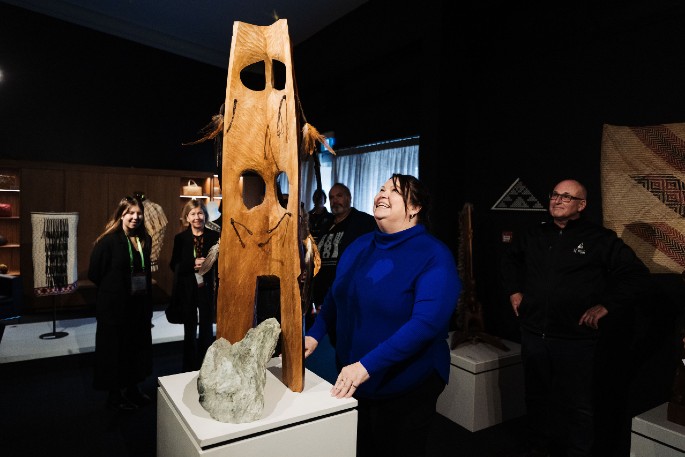This Content Is Only For Subscribers
A Tauihu carving was blessed and gifted to Business Events Industry Aotearoa yesterday, June 18, at the New Zealand Māori Arts and Crafts Institute.
This week Rotorua is hosting MEETINGS organised by BEIA – the biggest national trade show in Aotearoa New Zealand for the business events industry, where international buyers come together to discuss new business opportunities.
BEIA chief executive Lisa Hopkins says it was an incredibly humbling moment to see the taonga unveiled.
“We feel extremely privileged, and we also accept the responsibility and understand the importance of what has just happened. It’s a beautiful piece – it’s a new member of the team and I feel quite overwhelmed by the manaaki we’ve just been shown.”
Lisa says the genesis of this moment came together over a cup of coffee last year when BEIA was talking about bringing MEETINGS to Rotorua and what that might look like.
“We thought, wouldn’t it be great to have a taonga from the New Zealand Māori Arts and Crafts Institute Te Wānanga Whakairo Rākau (National School of Wood Carving) that could be put on display at our annual events, and which could be part of the BEIA organisation.”
New Zealand Māori Arts and Crafts Institute Pouako Whakairo Rākau (wood carving tutor) Hohepa Peni led the carving of the piece titled Waka Putanga, also working on it with tauira (students). He explained that a Tauihu is the front-end prow of a waka in miniature form which represents people coming from overseas for MEETINGS for an emergence of ideas.
The rākau is from a 3000-year-old log of kauri from Tā (Sir) Hekenukumai Busby, a Te Tai Tokerau elder who led the revival of traditional Māori navigation and ocean voyaging skills.
This same log of kauri was also used to carve a 10-metre waka maumahara at the World Expo in Shanghai in 2019 as part of the NZMACI Tuku Iho Living Legacy Exhibition.
Hohepa says the tauihu has a tongue shape cut out at the bottom which is referred to as the haumi kokomo – a specific join to extend the waka and make it longer.
“In a different context – haumi means ‘to join’ as a kaupapa (purpose) – it reflects how we seek to join ideas at this MEETINGS event, with the connecting of business,” says Hohepa.
“The two stylised figures represent tangata ora (the living) – the people who will be at MEETINGS and the people of BEIA.
“This form is also in putanga style, which means ‘to emerge’, to step out. We’ve also tried to keep this culturally accessible to all and we have contemporised the piece with hollowing out techniques which are more sculptural, to show off the rākau – it’s not over designed because it’s beautiful kauri.
“The pāua (abalone) shell inlays are an acknowledgement of travellers converging like rivers or seas.
“The kura (feathers) represent the dreams everyone brings for the future. At MEETINGS, attendees are looking for connections and outcomes to make their dreams become a reality. The feathers in an indigenous context connect us back with our tūpuna (ancestors),” Hohepa says.
Waka Putanga will now be installed at the Energy Events Centre at MEETINGS over the next two days.



